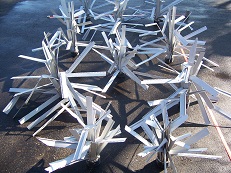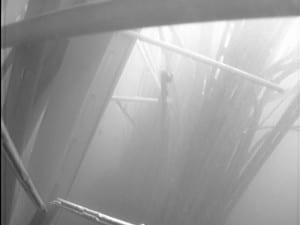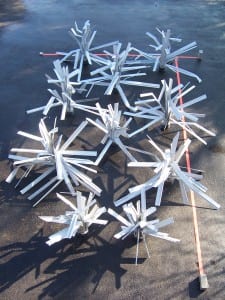
Photo: Kate Danson
 MNN: What is this book about and why did you decide to write it?
MNN: What is this book about and why did you decide to write it? Ted Danson: This book is about the crisis in our
oceans: How did we get here and how do we bring it back to abundance and health. I decided to finally sit down and write it because science is saying we are coming to a tipping point. And science also shows that our oceans can bounce back if we make some necessary changes. People should read this book and be worried about the state of the oceans but they should also walk away feeling hopeful and empowered, knowing that we still have time to solve this problem.
What influenced your dedication to the oceans growing up?
My father was an anthropologist and my mother was a very spiritual person. They taught me that we are part of the world we live in and that we have to understand it and be good stewards. I also had the benefit of having Hopi friends as a kid in Arizona and their appreciation for the natural world had a great influence on me. And while I grew up in Arizona, I always enjoyed the ocean on visits to see family in California. I had a very vivid dream when I was 7 years old. I had a high fever and I woke up screaming and I ran into my parents’ room. They asked me what was wrong and I described my nightmare. I was sitting on the beach and God’s voice said, “Ted, you have one hour to enter the oceans into this bucket,” and then he gave me a spoon with holes in it. Typical young actor’s megalomania in development, maybe, but you’d have to say I’ve been thinking about the oceans for many years!
Why did you feel the need to become an ocean activist?
During my fifth season doing “Cheers” I was living in Santa Monica. I was taking a walk with my daughters on the beach and we came to a sign that read: “Water polluted, no swimming.” I didn’t know how to explain to them why the beach was closed. That was my call to action.
What was the first issue you took on as an ocean activist and what are some of the lessons you learned during those early years of activism?
In the 1980s, the debate on
offshore drilling was starting up again. Occidental Petroleum was attempting to start slant drilling off the coast of Malibu. With the help of my friend Robert Sulnick, we set out to protect our coast from offshore drilling — and won. And, then we realized we could do a lot more and started our own oceans organization, American Oceans Campaign. During those early years I learned how much hard work it takes to be successful. I also learned that in order to be effective in conservation you need to rely on science. I have been so lucky to have been able to work with some of the finest ocean scientists and experts in the world.
What is the state of fisheries around the world today?
Eighty percent of seafood fisheries are at their limit of exploitation or already in collapse. We are destroying the oceans from the top down and from the bottom up, and not giving them a chance to recover. We overfish using illegal and destructive methods to take out too many
fish. Ninety percent of the large predator fish — sharks, tuna, marlin — in the oceans have disappeared. Carbon emissions cause climate change and ocean acidification, which attacks the lowest level of the food chain, harming coral reefs and killing off food that’s critical for the ocean ecosystem.
How is industrial fishing destroying our oceans and hurting the livelihood of people that depend on the ocean?
The global fishing fleet is estimated to be 2.5 times larger than what the oceans can sustain. Too often, destructive gear is used that kills everything its path. Industrial fishing ships with huge nets catch and kill marine life — dolphins, sea turtles,
birds. Bottom trawlers destroy deep sea coral and other seafloor habitats, which provide critical nurseries and feeding grounds for innumerable fish and shellfish species. Destructive fishing also jeopardizes the millions of small-scale fishermen and others who have depended on the oceans for their livelihood for generations. It also threatens the nearly 3 billion people in the world who rely on animal protein that comes from the sea.
Despite all of this, you see this as a pro-fishing book. Can you explain?
I want fishermen to be able to make a living for years to come. And, I want my grandchildren to enjoy fresh, healthy seafood that comes from an abundant ocean. I also want the more than three billion people who depend on fish as a major source of animal protein to be able to continue to do so. Many fishermen know their catch is shrinking. I have spoken with fishermen over the years — some are featured in the book — and they understand, and many support, that changes need to be made in the industry to let the fish populations recover.
Can you still eat seafood while being an advocate for the ocean? Do you still eat seafood?
I love to eat seafood. We should all be able to eat seafood if we choose, and for many people it is a major source of protein. I want people to continue to be able to rely on eating seafood. But we need to start fishing smart and also eating smart. The easiest way to do this is to ask questions. What kind of fish is it? Where was it caught? How was it caught? Was it farmed? Where was it farmed? One good rule of thumb is to try and eat locally caught seafood if you don’t have any more information. And, get a seafood guide. You can find them at
Oceana.org and other organizations.
What is seafood fraud and how does it affect consumers?
Seafood fraud has been discovered across the United States — less expensive fish like tilapia have been passed off as grouper and red snapper, for example. It is a disturbing trend and most people don’t know they have been lied to and ripped off, and it disguises the fact that overfishing is taking place. This creates an illusion that we have an endless supply of fish when in actuality, many of these species are on the brink of collapse. The fraud undermines efforts to convince the restaurant-going/supermarket-shopping public that overfishing is a real concern. How can you believe that grouper is at risk when you can have a so-called grouper sandwich every day?
What are fishing subsidies and how do they affect the taxpaying public?
Subsidies are payments governments make to fishing companies to keep fishing. They pay for fuel, nets, trawls and even the vessels themselves. They are paying fishing boats to overfish. Subsidies pay to maintain a global fishing fleet two-and-a-half times the capacity the oceans can sustain. This is less an issue in the U.S. Tax money pays to catch the fish, then we pay to eat the fish and we are destroying the oceans in the process, which makes the prices for fish higher.
What are flags of convenience and why are they dangerous?
Fishing ship owners flag vessels in places like Panama, the Marshall Islands or Bolivia. The ships then don’t have to adhere to stricter maritime laws from other nations. These boats can catch as many fish as they want in any manner they want. This practice leads to a more startling problem as well. These vessels skirt human rights laws and end up forcing their crew to work long hours in inhumane conditions while making pennies in comparison to the value of their catch.
How does fish farming affect the oceans and our own health?
Fish farming creates more pollution and overfishing pressure around the world. Irresponsible fish farms pollute with fish waste and introduce dangerous chemicals into the food chain (that we then can ingest). It takes up to 5 pounds of smaller fish — all of which are important species to the marine environment and many of which are edible for humans — to create 1 pound of farmed salmon, resulting in a net loss of protein.
How are offshore drilling and climate change related to the failing health of the oceans?
Offshore drilling can pollute the ocean even when there are no accidents because of how it takes place and the many opportunities for oil to end up in the sea. Drilling in the oceans continues to enable our dependence on oil and puts more carbon dioxide into our atmosphere, which leads to rising ocean temperatures and acidification.
What is ocean acidification?
We have filled our atmosphere, and our oceans, with carbon dioxide. As a result, the oceans’ pH balance is out of whack, and the water is becoming more acidic. Acidification prevents animals that build shells and skeletons out of calcium from doing so. Those animals, such as krill and coral reefs for example, are the heart of the ocean food web. Corals provide a home for 25 percent of marine life.
Considering your start in conservation, what were some of your thoughts as you learned about the Gulf of Mexico oil spill?
I was upset for the people in the Gulf. It didn’t need to happen again. This is the same cycle we have seen since the Santa Barbara spill in 1969. We have an oil spill. We react and stop offshore drilling. We are then lulled into a false sense of security because there has not been an accident in years. We loosen regulations. There is another disaster. I am hopeful that we can fix this, though.
What has happened since the BP spill and what still needs to happen?
The Obama administration has removed most of the U.S. coastline from drilling plans, except where drilling is already taking place and part of the Arctic. It’s a step forward, but it’s not enough. Offshore drilling will never be 100-percent accident-free, and we need better monitoring of the oil rigs that are still out on the water. We also need to have a strong commitment to invest in and implement clean energy technology — offshore wind has the potential to generate 30 percent more electricity than offshore oil and gas resources combined.
What can be done to bring the oceans back to health? What can individuals do in their everyday lives to help the oceans?
We need active enforcement of laws already on the books, and governments must stop distributing fishing subsidies that allow overfishing. We need a reduction in the size of the fishing fleet and the most harmful fishing gear should be eliminated. Nations around the world also need to protect habitat and allow fish populations to bounce back. Groups that manage fisheries internationally need to start protecting some of the species that are at risk like bluefin tuna, sharks, swordfish and forage species like krill. As for individuals, my first piece of advice would be to go and enjoy the oceans. Go for a walk on the beach, surf, fish, swim, boat, whatever you like. The more of us that are connected to the oceans the better. And, getting involved is fun and you can make a difference. You can join a group that works on ocean issues, like Oceana. Vote for representatives that want to improve the ocean’s health. And you can eat sustainable seafood and avoid products that are harmful to the oceans. We also need to manage what we put in the environment by reducing our plastic use and conserving our energy use.
Are you optimistic about the future of our oceans?
Yes, I am optimistic, and here’s why: The oceans are resilient. Fish populations can bounce back if given a breather from intense fishing pressure. And, I’ve been doing this for years and I am so impressed by how many more people are becoming aware of the importance of conservation all the time. Most of the oceans’ most vibrant ecosystems — coral reefs, for example — are near coastlines, and people are motivated to save them. We are getting the will, and now we just have to find the way.
This Q&A was provided by Rodale Books, publisher of “Oceana.” 
 Photo: Kate Danson
Photo: Kate Danson MNN: What is this book about and why did you decide to write it?
MNN: What is this book about and why did you decide to write it? 

